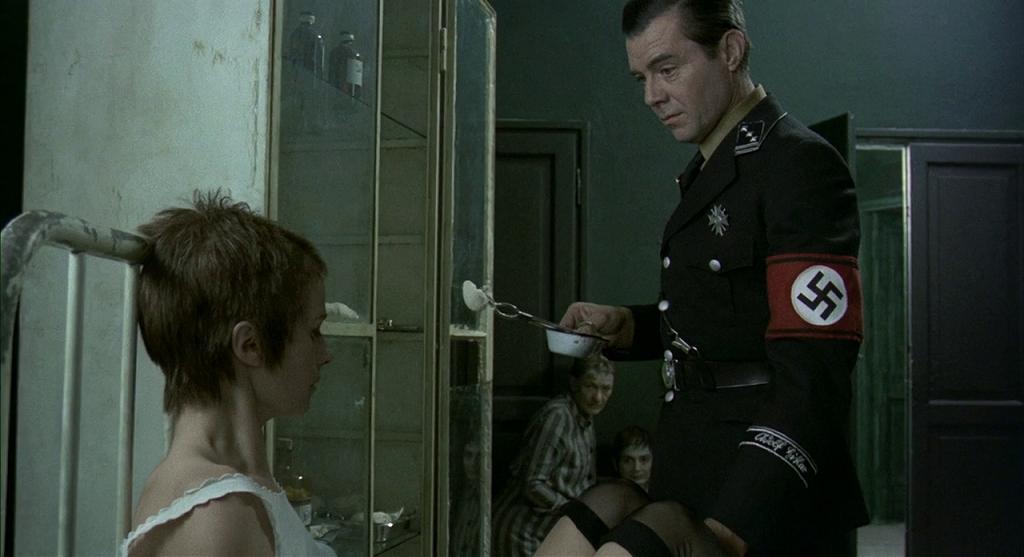6-8. Νίκος Γεωργίου Νικολαΐδης’s Singapore Sling: Ο Άνθρωπος που Αγάπησε ένα Πτώμα (1990), Θα σε Δω στην Κόλαση Αγάπη μου (1999), and The Zero Years (2005)

Another barely-known trilogy (with merely 1,785, 273, and 223 votes on IMDb, respectively) only known in all the worst circles for all the worst reasons, these three experimental films – filmed in fixed tableauxes with few camera movements yet with much self-aware fourth-wall-breaking expressive and bodily per-formance art-like acting reminiscent of a Joel-Peter Witkin photograph – are a test of the viewer’s intelligence, sincerity, and willingness to come to terms with non-taken-for-granted and counterintuitive knowledge about themselves after looking in the un-comforting and challenging mirror.
Featuring some of the most extreme sexually-sadistic fetishes of paraphilia and total domination ever recorded on camera, with a special focus on emetophilia, bondage, and various food- and electricity-related kinks, every viewer must hold to their most unconscious desires and submit themselves, after reading their synopses, into an expectation-free adventure becoming surprised over and over again to discover how their emotional and physical-visceral responses to the actions depicted on screen turn out to be the exact opposite of what they expected upon hearing about them.
“I feel wonderful inside this after-world of guilt, lost time, memories of my past and of my future [and] [n]aturally, this is where I seek all of my loves [as] [b]esides, the girls of paradise are so boring [so the trilogy] is a necro-romance about the darkness and the thrashing humidity of unfulfilled desires and of ghosts [and] [i]t’s where those marvelous carnivorous flowers […] blossom,” the di-rector, one of the most underrated in the entire history of cinema, stated.
9. Nagisa Ōshima’s L’Empire des sens (1976)

Like the previous entry on this list, this dramatization of a real-life Japanese pre-WWII case in which a courtesan willfully castrated her lover following a strangulation, one of the first and still one of the comparatively few films to feature unsimulated sexual intercourse, a fact that maintained its notoriety till this day especially in its home country where it is still cen-sored, asks its viewers to ponder how far will they go for their love and desire and whether boundaries can be said to exist in this realm of the senses.
Critic Joan Mellen opined that this film deals with “the capacity of a male figure to assume a liberated psyche, in this case becoming […] weaker and gentler and soft […] being a female figure […] [m]utual abandon is the goal: the male becomes passive, the recipient of please [and] [h]is pride derives not from dominance, but from the degree to which the woman responds […] remov[ing] the treatment of female sexuality from the linear no-tions of victimisation and questions of economic survival [i]t defies the illusion that domestic permanence is compatible with free sexual expression.”[3]
10. Liliana Cavani’s The Night Porter (1974)

Probably not as viscerally-shocking today as it was when it was first released compared to most films featured in this article, this widely-misunderstood tale of a Holocaust survivor and Nazi official secretly reliving their dominance and submission sadistic relationship (she is the sub) in postwar Vienna, the first film directed by a woman on this list, was largely dis-missed as a sensationally distasteful and trashy exercise in exploitative and salacious bad taste upon its release.
In her liner notes to the first Criterion Collection DVD re-lease of this film, critic Annette Insdorf suggests the film explores politically-incorrect ground and would likely never have been made in the academic ambience of today: “Cavani has never presented herself as a “feminist” director […] [and this film is] hardly concerned with positive female role models.”
11-12. Vilgot Sjöman’s Jag är nyfiken – en film i gult (1967) and Jag är nyfiken – en film i blått (1968)

Largely forgotten today (with only 3,095 and 1,111 votes on IMDb respectively) and probably also not as shocking to most audience as this diptych was back in its day, its boldness and erotic frankness largely eclipsed by more recent attempts, it was in fact subjected to a very longwinded and grueling legal (and media) battle in the United States over the rights to freely project its alleged ob-scenity therein, eventually reaching the Supreme Court, not after one of the theatres showing it was attacked by arsonists, even though most journalists typically and un-surprisingly were bored by much of its non-sexual content upon release.
Looking past the by-now passé shock tactics, one can learn more about emotional rather than sexual candor and highly appreciate this sympathetic but hardly uncritical semi-documentary cinéma vérité-style look at a young radical woman in 1960s countercultural Sweden revealing the naïve spirit of youthful utopian rebelliousness, the masks we wear at-tached so firmly no true self remains, and the impossibility of following up one’s ide-als.
As Sjöman noted in the insert contained in the Criterion Collection boxset: “I have covered many aspects of sex [and while the films end] with violence […] people tend to forget that it begins with humor and tenderness.”
13. Lars von Trier’s Nymphomaniac: Volume I (2013) and Nymphoma-niac: Volume II (2013)

Few people read novels, dramas, and poems or watch operas, let alone live their own lives and the emotional turmoil therein, the way style-obsessed formalist journalists insist one should watch films, that is, not by paying attention, perceptually and perceptively step-by-step in an unframed manner, to the vocal/verbal, emotional, and physical twists and turns in the characters’s behaviors and staying within the flow but by nailing Christ to the cross by skipping it all to find some gener-ic and archetypical hidden meanings one understands after two seconds by decoding camera positions.
The understanding that no one has of yet marshalled any convincing argument pertaining as to why film should supposedly be any different is the under-pinnings of von Trier’s Dogme95 movement, one of the most important in the entire history of cinema, demanding filmmakers forego gaudy formalistic tricks coercing viewers into easily-understandable generic themes and theses and redefining the taboo term “merely filmed theatre and literature without any cinematic gaze or language,” i.e. actor-, body-, face-, and emotion-based experiences so hated by testosterone-poisoned dudebros, as a positive.
This is why the master’s films are some of the greatest and most emotionally-profound in the entire history of the medium and this one is no ex-ception either. Closer to the emotional tenderness and truth of a Wolfgang Amadeus Mozart or a Richard Wagner than to pornography, like most of von Trier’s masterpiec-es, this long tale of a nymphomaniac’s sexual exploits, one of his most complex emo-tionally-wise, especially in the longer director’s cut, is a profound critique of the polit-ically-correct middle-class/bourgeois tabula rasa identitarian cult of sameness and equality, the bigotry of low expectations, and the infinite malleability of human nature and a reaffirmation of real natural diversity, responsibility, agency/subjective free will, and humanistic methodological individualism, a true celebration and affirmation of life. If consciousness and being are the ultimate art form, no wonder most journalists hate von Trier with a passion saved for few other directors.
14. Dušan Makavejev’s Sweet Movie (1974)

Foreshadowing Lars von Trier’s Idioterne (1998) not just with the concept of spazzing but also with its focus on adolescent-like angst and rebelliousness as a catalyst for the infantile seductions of radicalized virtue-signaling and featuring lengthy still-shocking performances by the Wiener Aktionismus performance-art group, this tale of a homicidal pedophiliac female communist sea-captain paralleled by a bizarre virginity-related Miss World contestant being sold off (and then escaping from the confines of) to a multimillionaire only to end up smearing herself with liquid chocolate for a television commercial is, according to the added to the Criterion Collection DVD written by critic David Sterritt, “Makavejev sees Soviet-style Communism as just another form of fascism, used by ruthless dictators to crush true Marxism under their power-mad heels [and] [i]t’s no accident that the [Karl] Marx figurehead on the ship Survival has a tear falling from its eye. Marx’s ideals, and his philosophy’s promise of a new and improved “socialist man,” were also buried in the Katyn Forest.”